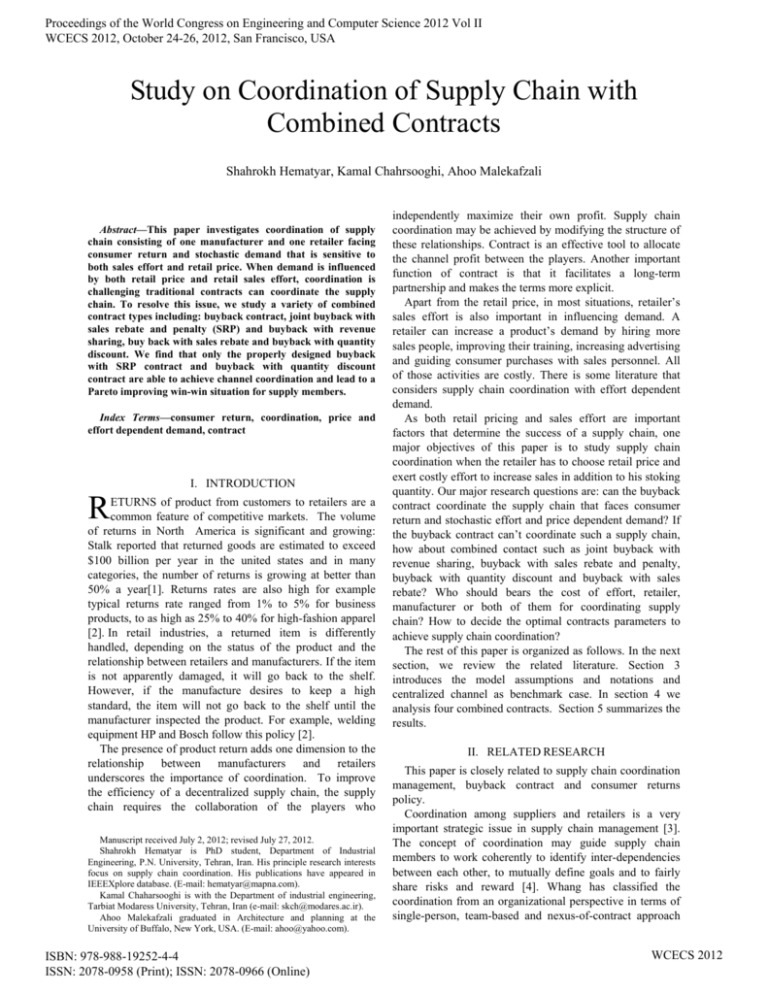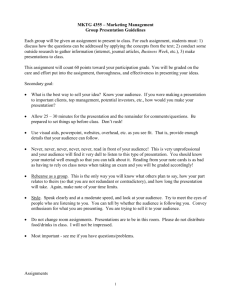Study on Coordination of Supply Chain with Combined Contracts
advertisement

Proceedings of the World Congress on Engineering and Computer Science 2012 Vol II
WCECS 2012, October 24-26, 2012, San Francisco, USA
Study on Coordination of Supply Chain with
Combined Contracts
Shahrokh Hematyar, Kamal Chahrsooghi, Ahoo Malekafzali
Abstract—This paper investigates coordination of supply
chain consisting of one manufacturer and one retailer facing
consumer return and stochastic demand that is sensitive to
both sales effort and retail price. When demand is influenced
by both retail price and retail sales effort, coordination is
challenging traditional contracts can coordinate the supply
chain. To resolve this issue, we study a variety of combined
contract types including: buyback contract, joint buyback with
sales rebate and penalty (SRP) and buyback with revenue
sharing, buy back with sales rebate and buyback with quantity
discount. We find that only the properly designed buyback
with SRP contract and buyback with quantity discount
contract are able to achieve channel coordination and lead to a
Pareto improving win-win situation for supply members.
Index Terms—consumer return, coordination, price and
effort dependent demand, contract
I. INTRODUCTION
R
ETURNS of product from customers to retailers are a
common feature of competitive markets. The volume
of returns in North America is significant and growing:
Stalk reported that returned goods are estimated to exceed
$100 billion per year in the united states and in many
categories, the number of returns is growing at better than
50% a year[1]. Returns rates are also high for example
typical returns rate ranged from 1% to 5% for business
products, to as high as 25% to 40% for high-fashion apparel
[2]. In retail industries, a returned item is differently
handled, depending on the status of the product and the
relationship between retailers and manufacturers. If the item
is not apparently damaged, it will go back to the shelf.
However, if the manufacture desires to keep a high
standard, the item will not go back to the shelf until the
manufacturer inspected the product. For example, welding
equipment HP and Bosch follow this policy [2].
The presence of product return adds one dimension to the
relationship between manufacturers and retailers
underscores the importance of coordination. To improve
the efficiency of a decentralized supply chain, the supply
chain requires the collaboration of the players who
Manuscript received July 2, 2012; revised July 27, 2012.
Shahrokh Hematyar is PhD student, Department of Industrial
Engineering, P.N. University, Tehran, Iran. His principle research interests
focus on supply chain coordination. His publications have appeared in
IEEEXplore database. (E-mail: hematyar@mapna.com).
Kamal Chaharsooghi is with the Department of industrial engineering,
Tarbiat Modaress University, Tehran, Iran (e-mail: skch@modares.ac.ir).
Ahoo Malekafzali graduated in Architecture and planning at the
University of Buffalo, New York, USA. (E-mail: ahoo@yahoo.com).
ISBN: 978-988-19252-4-4
ISSN: 2078-0958 (Print); ISSN: 2078-0966 (Online)
independently maximize their own profit. Supply chain
coordination may be achieved by modifying the structure of
these relationships. Contract is an effective tool to allocate
the channel profit between the players. Another important
function of contract is that it facilitates a long-term
partnership and makes the terms more explicit.
Apart from the retail price, in most situations, retailer’s
sales effort is also important in influencing demand. A
retailer can increase a product’s demand by hiring more
sales people, improving their training, increasing advertising
and guiding consumer purchases with sales personnel. All
of those activities are costly. There is some literature that
considers supply chain coordination with effort dependent
demand.
As both retail pricing and sales effort are important
factors that determine the success of a supply chain, one
major objectives of this paper is to study supply chain
coordination when the retailer has to choose retail price and
exert costly effort to increase sales in addition to his stoking
quantity. Our major research questions are: can the buyback
contract coordinate the supply chain that faces consumer
return and stochastic effort and price dependent demand? If
the buyback contract can’t coordinate such a supply chain,
how about combined contact such as joint buyback with
revenue sharing, buyback with sales rebate and penalty,
buyback with quantity discount and buyback with sales
rebate? Who should bears the cost of effort, retailer,
manufacturer or both of them for coordinating supply
chain? How to decide the optimal contracts parameters to
achieve supply chain coordination?
The rest of this paper is organized as follows. In the next
section, we review the related literature. Section 3
introduces the model assumptions and notations and
centralized channel as benchmark case. In section 4 we
analysis four combined contracts. Section 5 summarizes the
results.
II. RELATED RESEARCH
This paper is closely related to supply chain coordination
management, buyback contract and consumer returns
policy.
Coordination among suppliers and retailers is a very
important strategic issue in supply chain management [3].
The concept of coordination may guide supply chain
members to work coherently to identify inter-dependencies
between each other, to mutually define goals and to fairly
share risks and reward [4]. Whang has classified the
coordination from an organizational perspective in terms of
single-person, team-based and nexus-of-contract approach
WCECS 2012
Proceedings of the World Congress on Engineering and Computer Science 2012 Vol II
WCECS 2012, October 24-26, 2012, San Francisco, USA
[5]. Sahin and Robinson proposed price, non-price,
buyback, quantity flexibility, allocation rules, information
sharing and flow coordination as major categories of
coordination mechanisms [6]. The classification can
therefore be summarized as flow coordination and contractbased coordination.
Supply chain contract is a set of many clauses that offers
suitable information and incentive mechanism to guarantee
all supply chain members to achieve coordination and
optimize the supply chain performance. generally, the
contract analysis offers guidance in negotiating the terms of
relationship between supplier and buyer. The contracts are
designed to sort out conflicts that may crop up in future.
Various types of contracts have been established to
coordinate chain members and allow individual decisions to
be aligned with the whole system’s objective through an
agreement reached by the supply chain members. These
contracts include the quantity discount pricing scheme, the
wholesale price contract, the buy-back contract, the two-part
tariff, the quantity flexible contract, the backup agreement,
the revenue sharing contract and the sales rebate contract.
Cachon performed a detailed survey on the coordination
with contracts and kinds of contracts’ effect on the supply
chain coordination for a wide range of supply chain models.
[7]. Buyback is one of an important coordination contracts
which may help to achieve pareto improvement in supply
chain. Pasternack shows that a supply chain may be
coordinated when the supplier commit to buyback all unsold
unit at partial credit [8]. However, Emmons and Gilbert
incorporate retailer’s pricing decision and show that channel
coordinating using buyback contract may no longer be
feasible, unless the retailer can commit the selling price
prior to the selling season; otherwise, the retailer has an
incentive to set price too high [9]. Padmanbhan and Pang
analyze the interaction between manufacturer returns policy
and retail competition [10]. Krishan et al demonstrated that
the buyback contract adversely affected supply chain profits
and higher buyback prices induced low profits. Also,
buyback contracts could not coordinate the supply chain
without promotional cost-sharing agreements, unilateral
markdown allowances or additional constraints on the
buyback [11]. Taylor incorporates a buyback contract with a
target sales rebate contract to coordinate the supply chain
when the demand is sensitive to the sales effort of retailer
[12]. Chen incorporate buyback contract with consumer
return policy in a decentralized supply chain where retailer
simultaneously determine retail price and order quantity and
faces dependent stochastic demand [2].
Our model is similar in some sense to the one studied by
Taylor and Chen. However, in Taylor’s model the retail
price is assumed to be exogenous. We extend Taylor’s
model by allowing the price to become a decision variable
for the retailer. Besides the return policy considered in
Taylor, we also consider consumer return policy in the
model and use combined contract that inherit the advantages
of buyback. In Chen’s model is assumed price dependent
stochastic demand. In this study, we also extend the Chen’s
model [2]. Besides the return policy considered in Chen, we
also consider combined contracts and use another approach
for modeling price and effort sensitive random demand for
ISBN: 978-988-19252-4-4
ISSN: 2078-0958 (Print); ISSN: 2078-0966 (Online)
the newsvendor problem with consumer return policy.
III. THE MODEL ASSUMPTION AND CENTRALIZED
SUPPLY CHAIN
A. Model Assumption
Consider a supply chain where a supplier produces a
product and sells it through a retailer. The supplier produces
the product at a constant unit cost of $ c and sells it w .
Market demand for the product during a selling season, is
sensitive to both sales effort and retail price. The supplier,
knowing the characteristics of demand, need to decide
contract format and parameters to achieve the best
performance so entire supply chain. Let x be a random
variable representing customer demand.
f ( x p , e ) is
probability density and
F ( x p , e ) is
cumulative distribution of
demand random variable that is differentiable, invertible,
and strictly increasing in effort and decreasing in price. We
use g( e ) as retailer’s cost of exerting a effort level e,
where g( 0 ) 0 , g (0) 0 , g (0) 0
Before the start of the selling season, the supplier produces
Q units of the product and delivers them to the retailer who
then rises to sell them to the market at the retail price p
during the selling season. Retailer offers a refund amount
r p to consumers when the product is returned. The retailer
incurs a handling cost I r per unit return of consumer. The
manufacture incurs the inspection and disposition of the
returned units by consumers at an average handling cost of
I m per unit. Define I I m I r as the total unit cost for the
channel when the product is returned.
I
m
I
as the share of
the channel cost that is incurred by the manufacture.
Consumers return the products with probability G1 . At the
end of the selling season, the product that has not been sold
has a unit salvage values v .
The expected sales and expected left over are respectively
Q
S (Q, P, e) Q 0 F ( x p, e)d x .
(1)
We use notation
S (Q) instead
of
S (Q, P, e) for
I (Q, P, e) Q S (Q, p, e)
simplicity
(2)
B. Centralized channel
For centralized channel, the decision is to simultaneously
choose the selling price p and the quantity Q and e with the
objective to maximize the expected channel profit which
can be written as:
T (Q, p, e) [ p v (v r I )G1 ]S (Q) (c v)Q g (e)
(3)
Therefore, the problem faced by the integrated supply chain
(4)
is: Maximize
T (Q, P, e)
s.t.
Q 0 and
p 0and
e0
The partial derivatives of T ( P, Q, e) are as follows:
T (Q, p, e)
S (Q)
[( p v) (v r I )G1 ]
(c v )
Q
Q
(5)
T (Q, p, e)
S (Q)
S (Q ) [( p v) (v r I )G1 ]
p
p
(6)
T (Q, p, e)
S (Q)
g (e)
[( p v) (v r I )G1 ]
e
e
(7)
We also see that
WCECS 2012
Proceedings of the World Congress on Engineering and Computer Science 2012 Vol II
WCECS 2012, October 24-26, 2012, San Francisco, USA
2 T (Q, p, e)
Q
2
Because
p v, r v
2 T (Q, p, e)
Q 2
optimal
( p v) f ( x p, e) (v r I t )G1 f ( x p, e)
so
2 T (Q, p, e)
Q 2
(8)
therefore
0
is concave in Q for a given p and e . Thus, the
2 T (Q, p, e)
Q 2
Although we don’t need to assume that the integrated
supply chain’s profit function is concave or unimodal in
three decision variables, we need to assume there exists a
finite optimal quantity-effort- price, {Q * , p * , e * } . Then the
following first-order conditions are necessary for
coordination (but not necessarily sufficient):
Q
T (Q * , p * , e*)
p
IG1
1 G1
T (Q * , p * , e*)
e
0
(10)
A contract designed by supplier is said to coordinate the
supply chain if it is able to satisfy the first-order conditions
at Q * , p * and e * .
IV. THE DECENTRALIZED SUPPLY CHAIN UNDER
CONTRACT
A supply chain involves managing various resources such
as inventory, money and information between disparate but
dependent chain members. The conflicting objectives and
lack of coordination between supply chains may often cause
uncertainties in supply chain. The centralized control of
supply chain assures coordination but it may not be realistic,
whereas in decentralized control, supply chain members
optimize local decisions without considering the impact of
their decisions on the other member’s performance and
overall performance of supply chain. Hence, some
coordination mechanism is necessary utilizing which may
motivate the members to achieve coordination.
Unfortunately, when allowing the retailer to exert costly
effort and use retail price to influence demand, coordination
is challenging. Furthermore, coordination is complicated by
the fact that incentives to align the retailer’s order quantity
decision may distort the retailer’s effort and price decision.
In the rest of this part, we model problem with different
kind of contracts. In our model supplier bears share of
effort cost and the retailer ( 1 ) share of effort cost.
A. Buyback
The buyer is allowed to return any leftover units to the
supplier at the end of period at a fraction of purchase price.
Let the return credit for each unsold unit be b where
b (v, w) . Then Under the buyback contract, the retailer’s
profit function is
R ( P , Q, e )
[ p b (b r (1 ) I )G1 ]S (Q) ( w b)Q (1 ) g (e)
(11)
Then,
T (Q, p, e)
S (Q)
[( p b) (b r (1 ) I )G1 ]
( w b)
Q
Q
ISBN: 978-988-19252-4-4
ISSN: 2078-0958 (Print); ISSN: 2078-0966 (Online)
that is
IG1
1 G1
we find e * can
be the retailer’s optimal effort only if
0
(16)
Therefore retailer bears effort cost by himself until buyback
contract can coordinate supply chain.
By comparing (12) with (9) under above condition we find
that w amount is required to coordinate the retailer’s order
quantity.
wc
IG1
1 G1
(17)
Under consumer return policy and contract parameters in
(15-17), an arbitrary allocation of the optimal supply chain
profit can’t be achieved. Because by substituting (15-17)
into (11), we get the retailer’s expected profit function:
R ( P , Q , e ) T ( p , Q , e ))
(18)
Using (18), the supplier’s expected profit is zero.
So buy back contract with reasonable parameter cannot
coordinate the supply chain.
B. Buyback +Revenue Sharing
The before section show that buyback contract fail to
coordinate the retailer’s action. Here we combine the
advantage buyback contract with revenue sharing. With a
revenue sharing contract, the supplier charges a low
wholesale price to the retailer and shares a fraction of the
revenue generated by the retailer. Let 0 1 be the fraction
of supply chain revenue earned by the supplier, so (1 ) is
the fraction of revenue kept by the retailer.
Under the revenue sharing contract, the retailer’s profit
function is
R ( P , Q , e)
[(1 ) p b (b r (1 ) I )G1 ]S (Q) ( w b)Q (1 ) g (e)
(18)
Then,
R (Q, p, e)
S(Q)
{(1 )p b [b r (1 )I]G1}
( w b) (19)
Q
Q
R (Q, p, e)
p
(20)
(1 )S(Q) {(1 )p b [b r (1 )I]G1}
S(Q)
p
R (Q, p, e)
e
{(1 )p b [b r (1 )I]G1}
(21)
S(Q)
(1 )g (e)
e
Comparing (21) with (7), we find that e * can be the
retailer’s optimal effort level only
b
(12)
(14)
(15)
By comparing (14) with (7) at b v
(9)
(13)
retailer’s optimal price level if
should satisfy
p c (v r I )G1
F (Q ( p, e))
p v (v r I )G1
T (Q, p, e)
S (Q)
[ p b (b r (1 ) I )G1 ]
(1 ) g (e)
e
e
By Comparing (13) with (6) we find that p*
b v
*
T (Q * , p * , e*)
T (Q, p, e)
S (Q)
S (Q) [( p b) (b r (1 ) I )G1 ]
p
p
IG1
p
v
1 G1 1 G1
0
(22)
(23)
WCECS 2012
Proceedings of the World Congress on Engineering and Computer Science 2012 Vol II
WCECS 2012, October 24-26, 2012, San Francisco, USA
Therefore retailer bears effort cost by himself until this
combined contract can coordinate supply chain. by
comparing (19) with (9) at above condition we can find
Q* to coordinate the retailer’s order quantity if
w c
IG1 p
1 G1
(24)
Then buyback with revenue sharing contract can coordinate
the supply chain when demand is only influenced by the
effort cost. However, by comparing (20) with (6) we find
that p* can never satisfy
R ( Q , p , e )
0 given 0 .
p
Hence,
when demand is also influenced by retail price, supply chain
can’t be coordinated through joint buyback and revenue
sharing contract.
C. Buyback +Sales Rebate
The sales rebate contract is one of the contracts regimes,
and channel rebates are widely adopted in the different
industries. A channel rebate is a payment from a
manufacturer to a retailer based on retailer sales to end
consumers. The rebate contract has the effect of motivating
retailer to lower prices for increasing sales, so it is a good
application for system coordination.
Under the buyback and sales rebate contract, the retailer’s
profit function is
(24)
R ( P, Q, e)
[ p b ( b r ( 1 )I )G1 ] S( Q ) ( w b )Q ( 1 )g( e ) sL( d )
s is channel rebate for retailer and S 0 is target threshold for
retailer so a rebate s is paid by the supplier to the retailer for
each unit sold beyond the threshold S 0 . L(d) is expected
rebate offered by the supplier.
L( d ) E( S( Q ) S0 ) ( q S0 ) Q F ( x p , e )d x
S0
(25)
Then
T ( Q , p , e )
Q
[( p b ) ( b r ( 1 )I )G1 ]
(26)
S( Q )
( w b ) s( 1 F ( Q p , e ))
Q
T (Q, p, e)
S (Q)
S (Q) [( p b) (b r (1 ) I )G1 ]
p
p
(27)
T (Q, p, e)
S (Q)
[ p b (b r (1 ) I )G1 ]
(1 ) g (e) (28)
e
e
Compare (27) with (6) we find that p* satisfies
R ( Q , p , e )
0 if
p
b v
(29)
IG1
1 G1
, we know that
only when 0 is, e* can be the retailer’s optimal effort
level. We find that amount w is required to coordinate the
retailer’s order quantity as below
s 0
(30)
w c
D. Buyback +Sales Rebate and Penalty (SRP)
Before selling season, supplier offers a sales target to the
retailer, if the final sale quantity is above the target, the
supplier gives the retailer a rebate; otherwise, the retailer
gives a payment to the supplier as penalty.
Let T be target for the retailer and be rebate amount if
retailer sales is beyond the target or a penalty for each unit
of product unsold below T . The sales rebate and penalty is
required when the market incentives are insufficient [13].
Under the SRP contract considered in the paper, the retailer
enjoys rebates from the supplier because of the enhanced
sales; in the meantime, he is also under pressure of penalty
resulted from low sales.
Under the SRP contract, the retailer’s profit function is
(32)
R ( P, Q, e)
[ p b (b r (1 ) I )G1 ]S (Q) ( w b)Q T (1 ) g (e)
Then,
R (Q, p, e)
S (Q)
[ p b (b r (1 ) I )G1 ]
w b (33)
Q
Q
R (Q, p, e)
S (Q)
S (Q) [ p b (b r (1 ) I )G1 ]
p
p
(34)
R (Q, p, e)
e
(35)
[ p b (b r (1 ) I )G1 ]
IG1
1 G1
ISBN: 978-988-19252-4-4
ISSN: 2078-0958 (Print); ISSN: 2078-0966 (Online)
S (Q)
(1 ) g (e)
e
By Comparing (34) with (6) and (35) with (7) and (33) with
(9) we can find p* and e* and Q* if
b wcv
(36)
w c
IG1
1 G1
(37)
0
(38)
Hence the joint buyback and SRP contract can coordinate
the supply chain.
Substituting (36-38) into (32), we get the retailer’s expected
profit function:
R( P ,Q ,e ) T ( P ,Q ,e ) ( w c
IG1
)T
1 G1
(39)
Under buyback with SRP and contract parameters in (3638), an arbitrary allocation of the optimal supply chain
profit can be achieved by varying T and .
By using (39), the supplier’s expected profit is
S ( P ,Q, e ) ( w c
IG1
1 G1
By comparing (28) with (7), at b v
Hence this combined contract can’t coordinate the supply
chain. However, if s 0 , then buyback with sales rebate
becomes buyback contract, which can’t coordinate the
supply chain as shown in section A.
IG1
)T
1 G1
(40)
So the total supply chain profit can be split as
[ S ( P , Q , e ) , R ( P , Q , e ) ] between the supplier and the
retailer. Any profit allocation can be realized by changing
T and . Supplier should adjust T and such that the retailer
gets a profit larger than under a non-coordination contract.
If , share of the channel cost that is incurred by the
manufacture be zero, supplier’s expected profit increases.
(31)
WCECS 2012
Proceedings of the World Congress on Engineering and Computer Science 2012 Vol II
WCECS 2012, October 24-26, 2012, San Francisco, USA
E. Buyback +Quantity Discount
Quantity discount is widely applied in the industry. Under
quantity discount, the seller gives the buyer different
proportion preferential benefit in price according to the
amount of products the buyer buys, the lower the price is.
According to the different discount basis, quantity discount
can be divided into two kinds, all-unit discount and
incremental quantity discount. In an all-unit discount, when
the buyer’s quantity exceeds a given threshold, the
corresponding price decrease applied to all of the units that
he buys. In an incremental discount, when the buyer’s
quantity exceeds a given threshold, the corresponding price
decrease applies to only the additional. Here the quantity
discount form which the manufacturer provides to retailer is
goal unit’ quantity discount. The manufacturer establishes a
minimum standard of order L (0<L<Q). Only when the
retailer’s order quantity is greater than the minimum
standard of order L, the manufacturer gives certain price
discount for the part of order which exceeds the standard
quantity.
The discount rate is as follow:
1
d
d 1
QL
where 1 d1 0
QL
(41)
Under this combined contract, the retailer’s profit function
is
R ( P , Q , e)
So the total supply chain profit can be split as
[ S ( P , Q , e ) , R ( P , Q , e ) ] between the supplier and the
retailer. Any profit allocation can be realized by changing
L and . Supplier should adjust L and such that the
retailer gets a profit larger than under a non-coordination
contract. If 0 be, this combined contract the same as joint
buyback with SRP.
V. CONCLUSION
In this paper, we study coordination of a two-echelon
supply chain that retailer faces both effort and price
dependent stochastic demand and so retailer faces consumer
return. With the increase of product variety, consumers feel
much uncertain about whether specific items fit their needs.
If the items don’t fit, consumers wish return them. We
considered four combined contracts that inherit the
advantages of buyback contract. We find combination of
buyback with revenue sharing and buyback with sales rebate
can’t coordinate the supply chain. Whereas we find buyback
with sales rebate and penalty and buyback with quantity
discount can coordinate supply chain. Furthermore, we find
that, only when retailer bears all of effort cost, could
combine contracts (joint buyback with SRP and joint
buyback with quantity discount) coordinate the supply
chain.
(42)
[ p b (b r (1 ) I )G1 ]S (Q) ( dw b)Q Lw(1 d ) (1 ) g (e)
REFERENCES
Then
R (Q, p, e)
S (Q)
[ p b (b r (1 ) I )G1 ]
(dw b)
Q
Q
(43)
[1]
R (Q, p, e)
S (Q)
S (Q) [ p b (b r (1 ) I )G1 ]
p
p
(44)
[2]
R (Q, p, e)
S (Q)
[ p b (b r (1 ) I )G1 ]
(1 ) g (e) (45)
e
e
By Comparing (44) with (6) we find p* satisfies
R ( Q , p , e )
0
p
b v
[4]
if
IG1
1 G1
(46)
Comparing (25) with (7), at above condition, we know that
only when 0 is, we can find e* to coordinate the retailer’s
optimal effort level.
By comparing (43) with (9) at
Q*
satisfies
w
b v
IG1
1 G1
and 0 we find
R ( Q , p , e )
0 if
Q
[5]
[6]
[7]
[8]
[9]
c
IG1
d d (1 G1)
(47)
Hence the combined contract can coordinate the supply
chain.
Substituting (46-47) into (42), we get the retailer’s expected
profit function:
R ( P , Q , e ) T ( P , Q , e ) L( w c
IG1
)
1 G1
IG1
)
1 G1
ISBN: 978-988-19252-4-4
ISSN: 2078-0958 (Print); ISSN: 2078-0966 (Online)
[10]
[11]
[12]
(48)
[13]
Using (48), the supplier’s expected profit is
S ( P , Q , e ) L( w c
[3]
G. Stalk, “Customer returns top10 billion in 2005: most Canadian
retailers fail to capitalize on this key customer relationship, Harvard
business review,” Vol. 80, 2006
J. Chen, P. C. Bell, “Coordinating a decentralized supply chain with
customer returns and price-dependent stochastic demand using a
buyback policy,” European Journal of Operational Research, Vol.
212, 2011
H. Yong. Z. Xuan, Z. Lindu, “Coordinating a study supply chain with
effort dependent stochastic demand,” Applied Mathematical
Modeling, Vol. 33, 2009.
S. Arshinder. A. Kanda, S.G. Deshmukh, “Develop a tool for supply
chain coordination using contract,” management Research, Vol. 5,
2008.
W. K. Wong, J. Qi, S.Y. Leung, Coordinating supply chains with
sales rebate contracts and vendor-managed inventory, Production
Economics, Vol. 120, 2009.
F. Sahin, E.P. Robinson, Flow coordination and information sharing
in supply chains: Review, implication and directions for future
research. Decision Sciences, Vol. 33, 2002
G. Cachon, “Supply chain coordination with contracts,” Handbooks in
Operation Research and Management Science: Supply chain
management, North-Holland, 2003
B. Pasternack, “Optimal pricing and return policies for perishable
commodities,” Marketing Science, Vol. 14, 1985.
H. Emmons and S Gilbert, “The role of returns policies in pricing and
inventory decisions for catalogue goods,” Management Science, Vol.
44, 1998
V. Padmanabhan, J.P. Pang, “Manufacturer’s returns policies and
retail competition,” management Science, Vol. 16, 1997.
H. Kirshnan, R. Kapuscinski Dada, “Coordinating contracts for
decentralized supply chains with retailer promotional effect,”
Management Science, Vol. 50, 2004.
T. Taylor, “Supply chain coordination under channel rebates with
sales effort effects,” Management Science, Vol. 48, 2001.
M. Kolesar, D.L. Weisman, “Accommodative competitive entry
policies and telecommunications regulation,” Info, Vol.5, 2003.
(49)
WCECS 2012







